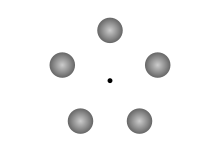Klemperer rosette
A Klemperer rosette is a gravitational system of (optionally) alternating heavier and lighter bodies orbiting in a symmetrical pattern around a common barycenter.[1](p 165) The regular polygonal configurations ("rosettes") do not require a central mass (a "sun" at the center is optional, and if present it may bobble above and below the orbital plane), although a Lagrange-type rhombus does.Klemperer does indeed mention this configuration at the start of his article, but only as an already known set of equilibrium systems before introducing the actual rosettes.It is notable that these fictional planets were maintained in position by large engines, in addition to gravitational force.[1](pp 165–166) The system is unstable regardless of whether the center of the rosette is in free space, or is in orbit around a central star.


hexagonalKlempererLagrangian pointselliptical orbitknown to occur naturallyrhombusgravitationalbarycenterW.B. Klemperercentral configurationrhombictrojan systemdumbbell-shapednonagontriangular pointsLagrangeLagrange-typepentagonalLarry NivenRingworldequilateralpolygonangular velocitycenter of massFleet of WorldsRingworld seriesPuppeteers'eponymousLernerpentagonPierson's PuppeteersKlemperer, W.B.Astronomical JournalBibcodeLagrange, Joseph-LouisAdadémie Royale des SciencesNiven, LarryLerner, EdwardTor Books